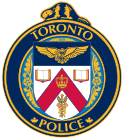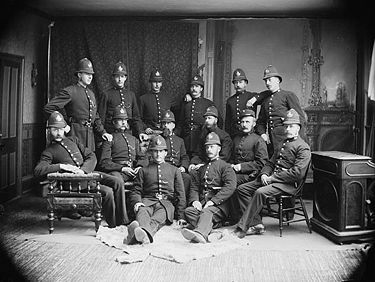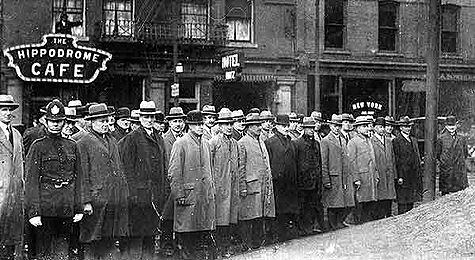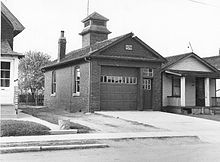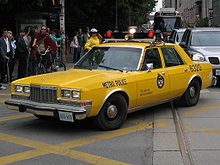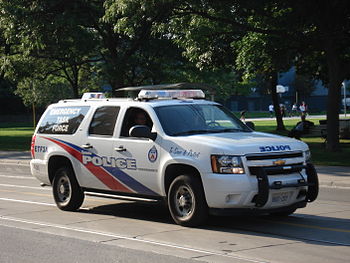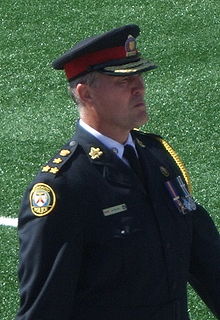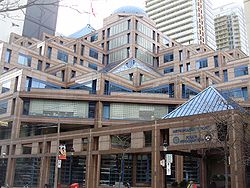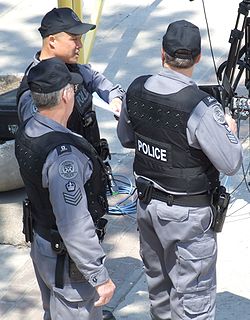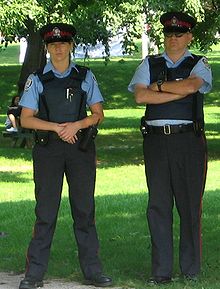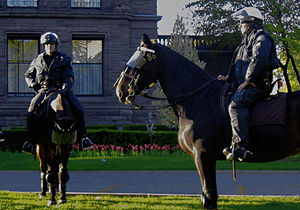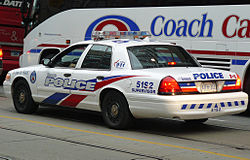- Toronto Police Service
-
Toronto Police Service Logo of the Toronto Police Service. Motto To Serve and Protect Agency overview Formed 1834 Legal personality Governmental: Government agency Jurisdictional structure General nature - Law enforcement
- Civilian agency
Operational structure Headquarters Toronto, Ontario, Canada Sworn members 5,598[1] Unsworn members 2,500 Agency executive Bill Blair, Chief of Police Facilities Divisions 17 Website www.torontopolice.on.ca The Toronto Police Service (TPS), formerly the Metropolitan Toronto Police, is the police service for the city of Toronto, Ontario, Canada. It is the largest municipal police service in Canada and second largest police force in Canada after the Royal Canadian Mounted Police (RCMP).[citation needed] At a budget of almost $1 billion it ranks second only to the Toronto Transit Commission (TTC) in city budgetary expense.[2]
Contents
History
1834 creation to 1859 reforms
The Toronto Police Service, was founded in 1834 when the city of Toronto was first created from the town of York. (Prior to that, local able-bodied male citizens were required to report for night duty as special constables for a fixed number of nights a year on the pain of fine or imprisonment in a system known as "watch and ward".)[3]
The Toronto Police is one of the English-speaking world’s oldest modern municipal police departments; older than, for example, the legendary New York City Police Department which was formed in 1845 or the Boston Police Department which was established in 1839. The London Metropolitan Police of 1829 is generally recognized as the first modern municipal department. In 1835, Toronto retained five fulltime constables—a ratio of about one officer for every 1,850 citizens. Their daily pay was set at 5 shillings for day duty and 7 shillings, 6 pence, for night duty. In 1837 the constables’ annual pay was fixed at £75 per annum, a lucrative city position when compared to the mayor’s annual pay of £250 at the time.[4]
From 1834 to 1859, the Toronto Police was a corrupt and notoriously political force with its constables loyal to the local aldermen who personally appointed police officers in their own wards for the duration of their incumbency. Toronto constables on numerous occasions suppressed opposition candidate meetings and took sides during bitter sectarian violence between Orange Order and Irish Catholic radical factions in the city. A provincial government report in 1841 described the Toronto Police as "formidable engines of oppression". Although constables were issued uniforms in 1837, one contemporary recalled that the Toronto Police was "without uniformity, except in one respect—they were uniformly slovenly." After an excessive outbreak of street violence involving Toronto Police misconduct, including an episode where constables brawled with Toronto's firemen in one incident, and stood by doing nothing in another incident while enraged firemen burned down a visiting circus when its clowns jumped a lineup at a local brothel, the entire Toronto Police force, along with its chief, were fired in 1859.[3]
1859 to 1900
The new force was removed from Toronto City Council jurisdiction (except for the setting of the annual budget and manpower levels) and placed under the control of a provincially mandated Board of Police Commissioners. Under its new Chief, William Stratton Prince, a former infantry captain, standardized training, hiring practices and new strict rules of discipline and professional conduct were introduced. Today's Toronto Police Service directly traces its ethos, constitutional lineage and Police Commission regulatory structure to the 1859 reforms.[4][5]
In the 19th century, the Toronto Police mostly focused on the suppression of rebellion in the city—particularly during the Fenian threats of 1860 to 1870. The Toronto Police were probably Canada's first security intelligence agency when they established a network of spies and informants throughout Canada West in 1864 to combat US Army recruiting agents attempting to induce British Army soldiers stationed in Canada to desert to serve in the Union Army in the Civil War. The Toronto Police operatives later turned to spying on the activities of the Fenians and filed reports to the Chief from as far as Buffalo, Detroit, Chicago and New York City. When in December 1864, the Canada West secret frontier police was established under Stipendiary Magistrate Gilbert McMicken, some of the Toronto Police agents were reassigned to this new agency.[6]
In 1863, the Toronto Police were also used as "Indian fighters" during the Manitoulin Island Incident when some fifty natives armed with knives forced the fishery inspector William Gibbard and a fishery operation to withdraw from unceded tribal lands on Lake Huron. Thirteen armed Toronto police officers, along with constables from Barrie, were dispatched to Manitoulin Island to assist the government in retaking the fishery operation, but were forced back when the natives advanced now armed with rifles. The police withdrew but were later reinforced and eventually arrested the entire band but not before William Gibbard was killed by unknown parties. (Sidney L. Harring White Man's Law: Native People in Nineteenth-Century Canadian Jurisprudence Toronto: Osgood Society-University of Toronto Press, 1998. pp. 152–153)
In the 1870s, as the Fenian threat began to gradually wane and the Victorian moral reform movement gained momentum, Toronto police primarily functioned in the role of "urban missionaries" whose function it was to regulate unruly and immoral behaviour among the "lower classes". They were almost entirely focused on arresting drunks, prostitutes, disorderlies, and violators of Toronto’s ultra-strict Sunday "blue law"[7]
In the days before public social services, the force functioned as a social services mega-agency. Prior the creation of the Toronto Humane Society in 1887 and the Children’s Aid Society in 1891, the police oversaw animal and child welfare, including the enforcement of child support payments. They operated the city's ambulance service and acted as the Board of Health. Police stations at the time were designed with space for the housing of homeless, as no other public agency in Toronto dealt with this problem. Shortly before the Great Depression, in 1925, the Toronto Police housed 16,500 homeless people that year.
The Toronto Police regulated street-level business: cab drivers, street vendors, corner grocers, tradesmen, rag men, junk dealers, laundry operators. Under public order provisions, the Toronto Police was responsible for the licensing and regulation of dance halls, pool halls, theatres, and later movie houses. It was responsible for censoring the content of not only theatrical performances and movies, but of all literature in the city ranging from books and magazines to posters and advertising.
The Toronto Police also suppressed labour movements which were perceived as anarchist threats. The establishment of the mounted unit is directly related to the four-month Toronto streetcar strike of 1886, when authorities called on the Governor General's Horse Guard Regiment to assist in suppressing the strike.
20th century
As for serious criminal investigations, the Toronto Police frequently (but not always) contracted with private investigators from the Pinkerton’s Detective Agency until the 20th century when it developed its own internal investigation and intelligence capacity.
During the 1930s and 1940s, the Toronto Police under Chief Dennis "Deny" Draper, a retired Brigadier General and former Conservative candidate, returned to its function as an agency to suppress political dissent. Its notorious "Red Squad" brutally dispersed demonstrations by labour unions and by unemployed and homeless people during the Great Depression of the 1930s. Suspicious of "foreigners", the police lobbied the city of Toronto to pass legislation banning public speeches in languages other than English, curtailing union organization among Toronto's vast immigrant populations working in sweat shops.
After several scandals, including a call by Chief Draper to have reporters "shot" and his being arrested driving drunk, the city appointed in 1948 a new Police Chief from its own ranks for the first time in the department's history: John Chisholm, a very able senior police inspector. In 1955, the Metropolitan Toronto Board of Police Commissioners was formed in preparation for the amalgamation of the 13 police forces in the municipality Metropolitan Toronto into a unified police force with Chisholm as chief of the unified force. Unfortunately Chisholm was not up to the politics of the Chief's office, especially in facing off with Fred "Big Daddy" Gardiner who engineered almost single-handedly the formation of Metropolitan Toronto in the 1950s. As the Toronto City Police absorbed the surrounding police departments and grew in size and complexity, Chisholm found himself unable to manage the huge agency and its Byzantine politics. In 1958, after a number of conflicts with Gardiner and members of the newly expanded Metropolitan Toronto Board of Police Commissioners, Chief Chisholm drove to High Park on the city's west end, parked his car and committed suicide with his service revolver. The late Staff Superintendent Jack Webster, one of the officers who arrived at the scene of the Chief's death and who would upon his retirement in the 1990s become the Force Historian at the Toronto Police Museum, would later write, "Suicide is a constant partner in every police car."
With the creation of Metro Toronto in 1954, the Toronto Police was eventually merged on January 1, 1957, with the other municipal forces to form the Metropolitan Toronto Police Force:
Former Police Force Current Community Field Division(s) Scarborough Police Department Scarborough Area 41, 42, 43 Etobicoke Police Department Etobicoke Area 22, 23 North York Police Department North York Area; parts of Central 31, 32, 33; parts of 12, 13, 53 East York Police Department East York Central 54 Mimico Police Department Etobicoke (Mimico) Area 22 Weston Police Department York (Weston, Ontario) Area and Central 12, 31 Forest Hill Police Department Toronto (Forest Hill, Ontario) Central 53 Town of Leaside Police Department East York (Leaside, Ontario) Central 53, 54 York Township Police Department York Central 13 New Toronto Police Department Etobicoke (New Toronto, Ontario) Area 22 Swansea Police Department Toronto (Swansea, Ontario) Central 11 Long Branch Police Department Etobicoke (Long Branch, Ontario) Area 22 In November 1995, the agency was renamed the Metropolitan Toronto Police Service [8] which in turn, in 1998, became the Toronto Police Service after the amalgamation of the former municipalities of metropolitan Toronto.
21st century
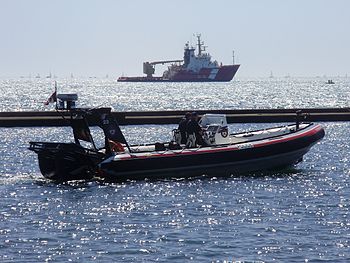 A Toronto Police marine patrol at the Canadian National Exhibition.
A Toronto Police marine patrol at the Canadian National Exhibition.
Today, the Toronto Police Service is responsible for overall local police service in Toronto and works with the other emergency services (Toronto EMS (TEMS) and Toronto Fire Services (TFS)) and other police forces in the GTA including:
- York Regional Police
- Peel Regional Police
- Halton Regional Police
- Durham Regional Police Service
- Ontario Provincial Police
- Royal Canadian Mounted Police
For most of 2005, the police union and the Toronto Police Services Board (the civilian governing body) were involved in lengthy contract negotiations. The rank and file had been without a contract since the end of 2004, and conducted a work-to-rule campaign in the fall of 2005. The police force is an essential public service and are legally prohibited from striking.
Controversies and allegations of misconduct
In 1988, Toronto Police were under scrutiny for the fatal shooting of a schizophrenic, Lester Donaldson.[9] The shooting was the first of eight over the next four years, in which mostly unarmed Black people were victims. Three days after his death, the Black Action Defence Committee, a group of local activists, was formed. The group made headlines when they introduced the issue of race in the coroner's inquest into Donaldson's killing.[10] In 1990, Toronto police officer David Deviney was charged with manslaughter in connection with the killing, though he was later acquitted.[9]
On May 4, 1992, tension between Toronto Police and the city's Black community reached its peak. After the fourth police killing of a young Black man, in as many years, a peaceful protest on Yonge Street later turned into a riot.[11] 30 people were arrested and 37 police officers were injured in the riot.
A mandatory Coroner's Inquest took place into the police killing of 17-year-old Jeffrey Reodica. Although accounts differ, it is generally accepted that Reodica was part of a group of Filipino teenagers pursuing a group of white teenagers on May 21, 2004, following altercations between the two groups. Plainclothes Toronto police officer Det.-Const. Dan Belanger and his partner Det. Allen Love were in the process of arresting Reodica when he was shot by the officers, the teen died in hospital three days later. Belanger and his partner, Det. Allen Love, were eventually cleared by the Special Investigations Unit (SIU) who accepted their story that Reodica lunged at them with a knife.[12]
In response to the recommendations of the Coroner's Inquest jury, Chief Blair recommended that all plainclothes police officers be issued arm bands and raid jackets bearing the word 'Police' in an effort to increase their visibility in critical situations. Unmarked cars, which are already equipped with a plug-in police light, will also be supplied with additional emergency equipment, including a siren package. The proposals will be phased in over three years beginning in 2008. Undercover officers will also have to wear, carry or have access to standard police use-of-force options such as pepper spray and batons.[13][14]
In 2004, eight people were shot by Toronto Police, and six of them died from their wounds. The SIU investigated each shooting, but found all of them to be justified.
In 2005, the police force was faced with a spike in shootings across Toronto and increased concern among residents. Police Chief William Blair and Mayor David Miller asked for additional resources and asked for diligence from residents to contend with this issue. Ontario Premier Dalton McGuinty promised to work with Toronto to fight crime.
In July 2007, Toronto Police were involved in an international incident in which their members pepper-sprayed, tasered, and handcuffed members of the Chilean national soccer team in an attempt to keep control of crowds after their semi-final match in the 2007 FIFA Under-20 World Cup. A police spokesman explained on CBC Radio on the programme Here and Now that police took action against individual members of the Chilean team when they "displayed aggressive behaviour" by vandalizing a bus and arguing with fans. The actions of the police were criticised by the TV and print media in Chile,[15][16] and initially also in Canada, but following a news conference and more detailed description of behaviour by the Chilean team the criticism (outside of Chile) was withdrawn. FIFA president Sepp Blatter later apologized to the Toronto mayor for the incident, and instigated disciplinary action against the officials and players of the Chilean team.[17]
Funding
As a division of the municipal government of Toronto, the Toronto Police Service's annual funding level is established by a vote of the Toronto City Council in favour of the year's proposed budget. Provided below are historical gross and net funding levels of the TPS as a part of the city's operating budgets.
Toronto Police Service funding as per municipal operating budgets Year Gross Amount % of Year's Gross Budget Net Amount % of Year's Net Budget 1999 $540,978,000 9.7% $522,900,000 20.3% 2004 $707,573,000 10.6% $679,112,000 23.3% 2010 $956,218,000 13.8% $919,112,000 26.7% As of 2011, a tentaive agreement will make Toronto police the country’s highest-paid officers by increasing wages over 11 per cent over the next four years. [18]
Chiefs of Police
Current Toronto Police Chief Bill Blair
The chief of police is the highest-ranking officer of the Toronto Police Service (until the 1960s the position was known as chief constable). Most chiefs have been chosen amongst the ranks of Toronto force and promoted/appointed from the ranks of deputy chief; Fantino was hired away from the York Regional Police, but he had been a career office with Metro Toronto Police.
Toronto Police Department
- William Higgins 1834
- George Kingsmill 1835
- James Stitt 1836
- George Kingsmill 1837–1846
- George Allen 1847–1852
- Samuel Sherwood 1852–1858
- William Stratton Prince 1859–1873
- Frank C. Draper 1874–1886
- H.J. Grasett 1886–1920
- Samuel J. Dickson 1920–1928
- Dennis Draper 1928–1946
- John Chisholm 1946–1956
Metro Toronto Police (up to 1995), Metro Toronto Police Service (up to 1998) and Toronto Police Service (1998 onwards)
- John Chisholm 1957–1958 (died 1958 from suicide)
- James Page Mackey 1958–1970 (died 2009)
- Harold Adamson 1970–1980 (died 2001)
- Jack W. Ackroyd 1980–1984 (died 1992)
- Jack Marks 1984–1989 (died 2007)
- William J. McCormack 1989–1995
- David Boothby 1995–2000
- Julian Fantino 2000–2005
- Mike Boyd 2005 (interim)
- Bill Blair 2005–present
Special Investigations Unit
The actions of the Toronto Police are examined by the Special Investigations Unit, a civilian agency responsible for investigating circumstances involving police and civilians that have resulted in a death, serious injury, or allegations of sexual assault. The SIU is dedicated to maintaining one law, ensuring equal justice before the law among both the police and the public. They assure that the criminal law is applied appropriately to police conduct, as determined through independent investigations, increasing public confidence in the police services. Complaints involving police conduct that do not result in a serious injury or death must be referred to the appropriate police service or to another oversight agency, such as the Ontario Civilian Commission on Police Services.
Operations
Toronto Police Headquarters is on College Street near Bay Street in the downtown area. The former HQ at Jarvis Street was turned into a museum (and since re-located to current HQ). The current site was once home to the Toronto YMCA. The current sign in over the main entrance still reads "Metropolitan Toronto Police Headquarters" and still has the seal of Metropolitan Toronto, and since 2007 has the current Toronto Police Service crest.[19]
The Toronto Police Service is divided into two field areas and 17 divisions (police stations or precincts):
Organizational structure
- Chief of Police
- Deputy Chief of Police
- Staff Superintendent
- Superintendent or Staff Inspector (Div. Unit Commander)
- Inspector (Divisional Unit 2IC)
- Staff Sergeant (Platoon Manager)
- Sergeant (Supervisor)
- Constable
- Sergeant (Supervisor)
- Staff Sergeant (Platoon Manager)
- Inspector (Divisional Unit 2IC)
- Superintendent or Staff Inspector (Div. Unit Commander)
- Staff Superintendent
- Deputy Chief of Police
Central Field Command
Encompasses the former cities of York, East York.
- 11 Division, 2054 Davenport Rd.
- 12 Division, 200 Trethewey Dr.
- 13 Division, 1435 Eglinton Av. W
- 14 Division, 150 Harrison St. (14 Sub-Station is located at Exhibition Place)
- 51 Division, 51 Parliament St.
- 52 Division, 255 Dundas St. W.
- 53 Division, 75 Eglinton Av. W.
- 54 Division, 41 Cranfield Rd.
- 55 Division, 101 Coxwell Avenue.
Area Field Command
Encompasses the former cities of North York, Scarborough and Etobicoke .
- 22 Division, 3699 Bloor St. W (22 Substation at 799 Islington Avenue)
- 23 Division, 5230 Finch Ave. West
- 31 Division, 40 Norfinch Dr.
- 32 Division, 30 Ellerslie Av.
- 33 Division, 50 Upjohn Rd.
- 41 Division, 2222 Eglinton Av. E.
- 42 Division, 242 Milner Av. E.
- 43 Division 4331 Lawrence Ave. E near Morningside Avenue
Note: Public Safety Unit is located at 4610 Finch Avenue East next to the former Charles O. Bick Police College
Support units in the Toronto Police Service consists of:
Specialized Operations Command
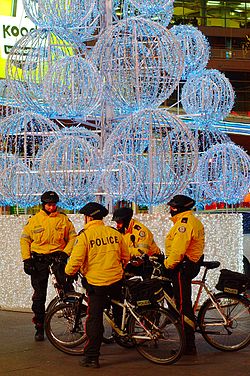 Toronto Police bicycle unit on a cold December evening at Yonge-Dundas Square.
Toronto Police bicycle unit on a cold December evening at Yonge-Dundas Square.
Detective Services
- Forensic Investigation Service, 2050 Jane St.
- Homicide Squad, 40 College St.
- Provincial ROPE Squad, 40 College St.
- Drug Squad, 40 College St. replaced Toronto Police Service's Central Field Command Drug Squad from the 1990s
- Organized Crime Enforcement , 40 College St.
- Fraud Squad, 40 College St.
- Hold-Up Squad, 40 College St.
- Intelligence Services, 40 College.
- Sex Crimes Unit, 40 College St.
- Integrated Guns and Gangs Task Force (Replaced the Asian Crime Unit, Hate Crimes Unit), Don Mills
- Toronto Anti-Violence Initiative Strategy (TAVIS), 5230 Finch Ave West.
Operational Services
- Communications Services, 703 Don Mills Rd.
- 911 Operations Centre, 703 Don Mills Rd.[20]
- Court Services, 40 College St.
- Prisoner Transportation Unit, 9 Hanna Avenue.
- Emergency Task Force, 300 Lesmill Rd.
- Marine, 259 Queen's Quay W.
- Mounted and Police Dog Services, 44 Beechwood Drive (1989)—Mounted Drill Unit
- 25 horses with 45 officers
- 21 officers with 17 general dogs, 4 drug dogs and 1 explosives detector dog
- Parking Enforcement East, 1500 Don Mills Rd.
- Parking Enforcement West, 970 Lawrence Ave West
- Public Safety and Emergency Management, 4610 Finch Avenue East
- Traffic Services, 9 Hanna Avenue.
- Transit Unit, 9 Hanna Avenue.
Community Mobilization Unit
- Auxiliary (Auxiliary Constable), Volunteer and Rover Program
- Youth Programs
- Empowered Student Partnership
- Toronto Recreational Outreach Program (TROOP)
- Public Education and Crime Eradication (PEACE) project
Policing on most 400-series highways (like King's Highways 401, 400, 427, 404) are in the jurisdiction of the Ontario Provincial Police. Toronto Police Traffic Services is responsible for patrolling on local highways (Allen Road, Don Valley Parkway, F.G. Gardiner Expressway and the Toronto section of Highway 409).
Workforce
The Toronto Police Service has approximately 5,710 uniformed officers and 2,500 civilian employees. Its officers are among the best paid in Canada. In October 2008, the Toronto Police Service was named one of Greater Toronto's Top Employers by Mediacorp Canada Inc., which was announced by the Toronto Star newspaper.[21]
Ranks
The rank insignia of the Toronto Police Service is similar to that used by police services elsewhere in Canada and in the United Kingdom, except that the usual "pips" are replaced by maple leaves.
Commanding officers
Besides the Chief of Police, the other command officers are the Deputy Chiefs. They head the command units.
- Divisional Policing Command: Peter Sloly
- Corporate Command: Michael Federico
- Specialized Operations Command: Jeff McGuire (acting)
The Chief Administrative Officer is a civilian post, held by Tony Veneziano.
Police senior officers
The day-to-day and regional operations are commanded by senior officers:
Investigative non-commissioned officers
Investigations are divided into crimes against persons and crimes against property. These investigations are conducted by:
- Detective Sergeant (equivalent rank to Staff Sergeant)
- Detective (equivalent rank to Sergeant)
- Detective Constable
Police officers
- Staff Sergeant
- Sergeant
- Constable—first class, second class, third class, fourth class
Sworn members
- Special Constable—Court Officers, Prisoner Transportation officers, Document Servers, Custodial Officers
Ranks
- Locational Administrator
- Shift Supervisor
- Supervisor
- Officer
Unsworn members
- Cadet in Training
- Toronto Police Service Rover Crew [22] (Restricted to Police Foundation students at Humber College Lakeshore Campus)
- Parking Enforcement Officer
- Station Duty Officers
- Communicator Operators
Training
New and current officers of the Toronto Police Service train at the Toronto Police College on Birmingham east of Islington. The initial training is two weeks, followed by 12 weeks at the Ontario Police College in Aylmer, Ontario and then six weeks of final training at Toronto Police College. Charles O. Bick College was closed in July 2009.
Uniform
Front line officers wear dark navy blue shirts, cargo pants (with red stripe) and boots. Winter jackets are either dark navy blue jacket design–Eisenhower style, single breasted front closing, two patch type breast pockets, shoulder straps, gold buttons, or yellow windbreaker style with the word POLICE in reflective silver and black at the back (generally worn by the bicycle and traffic services units). All ranks shall wear dark navy blue clip on ties when wearing long-sleeve uniforms.
Auxiliary officers (shown to the right) wear light blue shirts (long sleeve for winter and short for summer), with the badging of auxiliary on the bottom of the crest. Originally front line officer also wore light blue shirts but changed to the current navy blue shirts in the Fall of 2000.
Hats can be styled after baseball caps, combination caps,or fur trim Yukon (similar to the Ushanka) hats for winter. Motorcycle units have white helmets. Black or reflective yellow gloves are also provided to officers with Traffic Services. Front line officers usually wear combination caps since that is the location of their badge. Prior to the 1990s, female officers wore bowler caps instead of combination caps. Auxiliary officers wear combination caps with a checkered red and black band. The Mounted Unit wear black Canadian military fur wedge cap during the winter months and Custodian helmet for ceremonial use.
As is the case with all Ontario Law Enforcement Officers, uniformed officers wear name tags. They are in the style of "A. Example" where the first letter of the first name is written and the last name next to it. Name tags are usually stitched on with white stitching on a black background, but they also have pin-styled with black lettering on a gold plate.
Senior officers wear white shirts and a black Eisenhower style jacket.
Specialized operations
Emergency Task Force
Main article: Emergency Task Force (TPS)The Emergency Task Force (ETF) is the tactical unit of the Toronto Police Service. It is mandated to deal with high-risk situations like gun calls, hostage taking, barricaded persons, emotionally disturbed persons, high risk arrests and warrant service, and protection details. The unit was created in 1965. An earlier non-SWAT Riot and Emergency Squad emerged in 1961.[23] Part of its role is now undertaken by the ETF, Public Safety and Emergency Management and the Mounted Unit.
Marine unit
TPS is one of several police forces along Lake Ontario with a marine unit.
TPS has a fleet of 15 boats based along marine unit stations in south Etobicoke (Humber Bay West Park), Toronto Harbour and Scarborough (Bluffer's Park):
TPS Marine unit works in conjunction with:
- Canadian Forces Search and Rescue unit at CFB Trenton
- Peel Regional Police Marine Unit
- Durham Regional Police Marine Unit
- Niagara Regional Police Service Marine Unit
- Halton Regional Police Marine Unit
- Hamilton Police Service (Ontario) Marine Unit
Mounted unit
The horse unit was formed in 1886 to provide crowd control and now stationed at the Horse Palace at the Canadian National Exhibition (CNE). The unit has been based at Casa Loma, Toronto Zoo, Sunnybrook Stables and at various division in Scarborough, Ontario, and North York, Ontario. The unit has a strength of 27 horses and 40 officers.
Police horses Honest Ed and Spencer were invited to the swearing in of United States President Barack Obama by Michigan’s Multi- Jurisdictional Mounted Police Drill Team and Color Guard.[24]
Horses
- Honest Ed (2004); named for Ed Mirvish
- Samson
- Lady
- General
- Harry
- Keith
- Dragoon; named after the type of cavalryman Dragoon
- Spencer
- Winston
- Royal
- Dundas; named after Dundas Street
- Lincoln; named after former Lieutenant Governor of Ontario Lincoln Alexander,
(Retired to Durham horse farm, September, 2011)
- Boot ; named after former chief David Boothby
- Simcoe; named after John Graves Simcoe
- Blue Moon
- Sabre
- Elvis; named for Mount Unit officer killed on duty
- Dorothy
- Thor
- Stuart
- Champ
- Viscount
- Toby
- Duke
- Champ
- Trooper
- Charger
- Juno Beach
- Major
- Justice
Horses killed while on duty:
- Brigadier (born 1998 near Listowel, Ontario): 2006—motor vehicle collision
- Lancer: 2002—motor vehicle collision
Police dog services
The Toronto Police K-9 unit was created in 1989 and is deployed to search for suspects, missing persons and other duties. The service has 17 general purpose dogs. Nero and Rony are dogs attached to this unit. There are 4 drug enforcement dogs and 1 explosives detector dog. The 21 officers and dogs are assigned to this unit and based at 44 Beechwood Drive in Toronto East York
Court Services
In the early 1980s, the Toronto Police Service initiated the hiring of civilian personnel to fill the position of Court Officer. Court Officers are primarily responsible for the safety and security of the public within Toronto's court locations, as well as the transportation, security, and safety of over 400 prisoners attending court each day. Prior to 1980, this function was performed by uniformed Police Officers under the supervision of a Police Sergeant at each court location. In 1980, the first class of twenty civilian employees were appointed by the Police Services Board to replace the uniformed Police Officers at the court locations. These Court Officers were sworn in as Special Constables, pursuant to the provisions of the Police Services Act, which conferred onto them the powers of Police Officers for the performance of their duties.
As the city’s policing needs expanded, so did the continued civilianization of Court Services. In 1984, the first civilian supervisors were trained to replace the Police Sergeants. These supervisors reported to a Detective Sergeant who was responsible for managing all the TPS personnel assigned to a particular court location.
In the mid 1980s, the Summons Bureau became a part of Court Services and the Civilian Summons Servers and support staff took on an expanded role under the newly created Document Services Section. The title Summons Server was changed to Document Server to reflect the expanded responsibilities. Document Servers are responsible for serving summonses, subpoenas and other court documents on individuals required to attend Toronto courts.
Court Services later took on the responsibility of overseeing the Matrons, now referred to as Custodial Officers, which is a small but dedicated group of employees tasked with managing female prisoners at a central location.
By 1990, Court Officers had taken over the responsibility of transporting prisoners in specialized wagons between the court locations, divisions and correctional facilities; a task previously performed only by uniformed Police Officers. This centralized service became known as the Prisoner Transportation Section. By 1995 Court Services promoted its first civilian to the position of Location Administrator, replacing the Detective Sergeants who were formerly in charge of the court locations. Today all sections within Court Services are managed by civilian Location Administrators. These Location Administrators report to one of two Staff Inspectors, who in turn report to the Superintendent of Court Services.
The role of the Special Constable within Court Services has developed significantly beyond its original mandate. As new laws were introduced by Parliament, and the City’s law enforcement needs became increasingly complex, Court Services evolved to assist the TPS in meeting those demands.
Court Services now employs over 700 of the Service’s 2500 civilian employees. It comprises several subunits including Prisoner Transportation, Document Services, the Training Section, and the Computer Assisted Scheduling of Courts (CASC). The role of the Special Constables within these subunits includes the service of legal documents; the execution of warrants; the collection DNA samples from convicted offenders; assisting the TPS Public Order Unit in maintaining order during public demonstrations; and being involved in all aspects of the Court Officer hiring and training process. In addition, members of Court Service are often utilized by the TPS for other specialized community outreach initiatives, such as the TPS Aboriginal Peacekeeping Unit; the TPS United Way fund raising initiative; and the Toronto Drug Treatment Court.
The growth in size of the Court Services Unit necessitated the creation of several specialized functions. A centralized Risk Management Section was created, tasked with the responsibility of investigating any complaints and disciplinary issues involving Court Services personnel. It is staffed by a team of detectives, under the supervision of a Detective Sergeant. The position of Crown Police Liaison Officer was also created allowing for a Detective Sergeant at each criminal court location who is dedicated to assisting the Crown’s Office with the processing of court cases.
As the City’s demand for additional court rooms increases, so does the responsibility of Court Services. There are currently 16 court locations across Toronto, with a total of 257 court rooms. In 2008, approximately 106,000 in-custody accused appeared in these court rooms. Also in that year, the Prisoner Transportation Section transported approximately 186,000 prisoners between police divisions and to and from detention centres. This required a professional staff of clerks, Police Officers and Special Constables, all working collaboratively in an impressive demonstration of excellence through people and partnerships.
Toronto parking enforcement
Parking enforcement on all roads and public property are the responsibility of Toronto Police.
Uniforms
TPE officers are provincial offenses officers able to issue parking tickets under part II of the Ontario Provincial Offenses Act. They do not carry any use of force items and are unarmed, but are issued Kevlar vests for safety. They are peace officers pursuant to section 15 of the Police Services Act of Ontario for the purpose of enforcing Municipal By-Laws.
Their uniform consists of a blue shirt, black cargo pants with blue stripe, a black vest and a cap with blue stripe. Boots are similar to front line TPS officers. In winter months TPE officers have a blue jacket with reflective trim. Patches on the jackets and shirts are similar to the TPS, but with a white back ground the blue wording "Parking Enforcement".
Fleet
Their vehicles have the same paint scheme as the older TPS squad cars, but they are labeled with Parking Enforcement and fleet numbers PKE(East) or PKW (West).
Toronto school crossing guards
Adult crossing guards at various intersections and crosswalks are employed and paid by the TPS. They are under charge by various Division across the city.
Uniforms
Besides wearing the reflective vest (yellow and orange), crossing guards are supplied with a police issue jacket. The jackets have a patch similar to the TPS, but it has a white background and identification as school crossing guards. A winter hat similar to the Ushanka are worn in cold weather.
Toronto Police Service (TPS) Lifeguard Service
93 life guards are responsible for patrolling 11 beaches and 44 kilometres of shoreline. The life guards are on duty during the summer months and are assisted by the TPS (including the Marine Unit), Toronto Fire Services and Toronto EMS.
Logo
The components of the TPS logo is similar to the old Metro Toronto Police logo less the name change:
- winged wheels of industry on the top part of the shield representing transportation
- crown commemorating the coronation year of Queen Elizabeth II in 1953
- two books represent education or knowledge
- A caduceus—herald's staff, associated with Mercury, protector of commerce
- chevron for housing
- Sheaf with York Rose on the sides of the crest
- beaver represents industry and/or Canada—from the old and new Coat of arms of Toronto
- ribbon containing the words Toronto Police
Prior to the Metro Police, the Toronto Police Department officers wore a generic Scully badge on their caps, a common shield used by Canadian police forces in the 19th and early 20th Century. This featured a metallic maple leaf with a beaver and crown.
Fleet
Police cars, also known as police cruisers are the standard equipment used by Toronto Police officers for transportation. The vehicles are numbered in regards to their division and car number. For example, 3322 represents that the vehicle is from 33 Division, and the following 22 is the vehicle designation number.
Other fleet numbering patterns include:
- Area Field Command Unit – AFCXX
- Bail Compliance Unit—BCUXX
- Bike Patrol Unit—XXX
- Central Field Command—CFCXX
- Chief of Police—CHIEF
- Command Vehicles—COMDXX
- Court Services—CRTXX
- Courier—RMSXX
- Emergency Task Force—ETFXX
- Forensic Identification Services—FISXX
- Information Technology Services—ITSXX
- Marine Unit—MUXX
- Mounted Unit Services—MTDXX
- Parking Enforcement—PKEXX (East)/PKWXX (West)
- Police Dog Services—PDSXX
- Public Safety Unit—PSUXX
- School Resource Officer—SROXX
- (Marine) Service Vehicle—SRVX
- Spare Vehicles—7XX
- Toronto Anti-Violence Intervention Strategy (TAVIS)—TAVXX
- Toronto Police Tow Trucks—8XX
- Traffic Services/Transit Patrol Unit—6XXX / 66XX
- Video Services Unit—VSUXX
Motor vehicles
M1A1 Abrams General Police Vehicle
Make/Model Type Status Origin Chevrolet Camaro Highway Unit retired  United States
United StatesChevrolet Caprice General police vehicle retired  United States
United StatesChevrolet Cavalier Parking Enforcement, Document Services Section  Mexico
Mexico United States
United StatesChevrolet Impala General police vehicle retired  Canada
CanadaChevrolet Malibu (2001–2005) Community Sweeper Unit car  United States
United StatesChevrolet Malibu (2006) Parking Enforcement Unit  Canada
CanadaDodge Neon Parking Enforcement, Document Services Section  United States
United StatesSmart fortwo Parking Enforcement car  Germany
GermanyFord Crown Victoria (marked) General police vehicle, Traffic Services, Community Sweeper Unit  Canada
CanadaFord Crown Victoria (black/blue stripe, grey/grey stripe) Stealth Police Cruiser.  Canada
CanadaFord Focus Parking Enforcement car  United States
United StatesFord Taurus (Highway Patrol) retired  United States
United StatesPlymouth Caravelle General police vehicle retired  United States
United StatesVolkswagen New Beetle Safety Bug car  Mexico
MexicoHonda Civic/Civic Hybrid Parking Enforcement car  Japan
Japan Canada
CanadaBMW K1 (K75RT) motorcycle  Germany
GermanyHarley Davidson FLHTP motorcycle  United States
United StatesWatercraft
Unit # Make Type Marine Unit 1 Hyke Industry Dive Platform & Command Vessel marine boat with Volvo Penta Turbo Chargd 350 hp (260 kW) engines Marine Unit 3 Tyler Nelson design built by Bristol Marine Long Range Search and Rescue Vessel Marine Unit 4 Hyke Industry patrol boat Marine Unit 5 Taylor wooden motor boat—patrol boat Marine Unit 7 Hyke Industry patrol boat SRV1 service vessel Marine Unit 21–23 Zodiac Hurricane 30-foot (9.1 m) Zodiac Rigid-hulled inflatable boat (RIBs) with twin 300 horsepower (220 kW) four-stroke motors Marine Unit 12 fan boat Marine Unit 8 Zodiac 28-foot (8.5 m) Zodiac with a Covered Wheelhouse, Twin Turbo-Disel Jet Drive Engines 1 "HUSKY" airboat used for operating over ice MU00 Seadoo GTX-4 personal watercraft Support vehicles
Make/Model Type Origin Chevrolet Express van—Commercial Vehicle Enforcement, Collision Reconstruction  United States
United StatesGMC Savanna vans—Radio Services and Court Services  United States
United StatesGMC C series light truck ETF  United States
United StatesChevrolet Suburban SUV—ETF, Marine Unit, Police Dog Service, Public Safety Unit, Radio Services  United States
United StatesFord F350 pickup truck with horses trailer—Mounted Unit  United States
United StatesArmet Armoured Vehicles Incorporated/Ford Trooper—using F-550 chassis tactical vehicle—ETF  United States/
United States/ Canada
CanadaFord Van Explosive Disposal Unit, Forensic Identification Service  United States
United StatesFord F-series or GMC Vandura trucks Prisoner Transportation Services Court Wagons  Canada
CanadaFreightliner Trucks FL mobile mobile command unit  United States
United StatesFord F-series truck chassis tow truck  United States
United StatesFord Van van RIDE  United States
United StatesGMC Safari SUV Parking Enforcement  United States
United StatesJeep Cherokee SUV  United States
United StatesNorthrop Grumman Remotec Andros MK V1A and Andros F6B bomb unit robots  United States
United StatesGeneral Motors Diesel Division T6H −5307 series Metro Police Auxiliary AUX1 and AUX 2 bus—ex-Toronto Transit Commission 7960  Canada
CanadaMotor Coach Industries MCI 102A 2 recruitment buses  Canada
CanadaMotor Coach Industries MCI-9 bus  Canada
CanadaOrion Bus Industries Orion I bus  Canada
Canada– Community Relations trailer—community donated  Canada
CanadaBicycles
Make/Model Type Origin Norco Bicycles Cross Country mountain bike  Canada
CanadaAquila Scandium mountain bike—Community Action Policing Sidearms and weapons
- Glock 22: Large frame .40 with hollow point bullets 200 grain —Regular uniformed officers
- Glock 27: Compact frame .40—Detectives
- Glock 17: Large frame 9 mm—Emergency Task Force (TPS)
- Glock 19: Compact frame 9 mm—Emergency Task Force (TPS)
- Pepper spray (OC spray): Regular uniformed officers
TPS formerly used Smith & Wesson prior to switching over to the Glock.
Weapons used by the ETF include:
- MP5A3 9 mm submachine gun
- Remington 700 bolt-action sniper rifle
- Remington 870 shotgun (Can be issued to Regular Uniformed Officers)
- Mossberg M500 shotgun (Can be issued to Regular Uniformed Officers)
- Diemaco C8 carbine rifle (Can be issued to Regular Uniformed Officers)
- Taser International M18 taser
- Taser International X26 taser
- Pepper spray (OC Spray)
- Tear gas (CS Gas)
- Rubber bullets or bean bags rounds
- ARWEN 37 37 mm riot gun (and AR-1 plastic baton rounds, may also be available to crowd/riot control officers)
- Long Range Acoustic Device: Three (one for Marine Unit, two for Public Safety Unit)[25]
Emergency services
TPS is part of Toronto's Emergency Services and works along side with:
- Toronto Fire Services
- Toronto EMS
- Heavy Urban Search and Rescue
See also
- Integrated Security Unit
- Auxiliary Constable
- Emergency Task Force
- History of crime in Toronto
- TTC Special Constable Services
References
- ^ Rush, Curtis (2011-08-31). "Chief Blair says 1,000 cops could be axed in budget cuts". Toronto Star. http://www.thestar.com/news/crime/article/1047485--chief-blair-says-1-000-cops-could-be-axed-in-budget-cuts?bn=1.
- ^ Policing costs skyrocketing
- ^ a b Toronto Police in 1834 – 1860 "Formidable Engines of Oppression"
- ^ a b http://www.russianbooks.org/crime/cph4.htm Toronto Police in the 1850s The Gangs of Toronto and the Call For Reform
- ^ http://www.russianbooks.org/crime/cph5.htm Toronto Police in 1859 -1875 The Militarization of the Constables
- ^ Military-Intelligence Functions of the Toronto Police During the U.S. Civil War Era and the Fenian Threat
- ^ History of the Toronto Police Part 4: 1875 – 1920
- ^ http://www.torontopoliceboard.on.ca/minutes/1997/october.doc
- ^ a b The Police Shooting of Lester Donaldson UARR. Accessed on January 28, 2011.
- ^ K.K. Campbell, "LAWS CHARGES METRO POLICE BIAS AGAINST BLACKS `WORSE THAN L.A.'" Eye Weekly, October 1, 1992
- ^ Raghu Krishnan, "Remembering Anti-Racism", This Magazine, January 2003.
- ^ Police killed unarmed teen, family says
- ^ Jeffrey Michael Reodica Inquest Jury Recommendations, Office of the Chief Coroner of Ontario
- ^ Toronto Police Services Board, Minutes of the Meeting of April 26, 2007, pages 85–90
- ^ Chilean soccer team involved in melee with police
- ^ La Nacion.cl
- ^ FIFA vows action after U-20 brawl
- ^ White, Patrick (May 5, 2011). "Toronto police would be country's highest-paid under contract offer". The Globe and Mail (Toronto). http://www.theglobeandmail.com/news/national/toronto/toronto-police-would-be-countrys-highest-paid-under-contract-offer/article2012160/.
- ^ Torontoist: Lazy Avec Le "Metro"
- ^ Toronto Police Service :: To Serve and Protect
- ^ "Reasons for Selection, 2009 Greater Toronto's Top Employers Competition". http://www.eluta.ca/top-employer-toronto-police-service.
- ^ Toronto Police Service: Rover Program
- ^ http://www.torontopolice.on.ca/publications/files/reports/1997annualreport/building.html#emergency
- ^ Swainson, Gail (January 16, 2009). "Toronto police duo saddles up for Obama". Toronto Star. http://www.thestar.com/news/world/uselection/article/572006--toronto-police-duo-saddles-up-for-obama. Retrieved 2009-01-16.
- ^ Police Will Keep G20 Sound Cannons
External links
- Toronto Police Official Site
- Toronto Police Services Board
- History of Policing In Toronto
- Toronto Police History
- Toronto Police history 2
- 22 Division Toronto Police Service Rovers
- Inquest into Jeffrey Reodica shooting begins
 Government and politics of TorontoMayor · City Council · Toronto Public Library · Toronto District School Board · Toronto EMS · Toronto Fire Services · Toronto Community Housing · Heavy Urban Search and Rescue · Toronto Police Service (Board) · Toronto Support Services Division · Toronto Technical Services Division · Toronto Water · Toronto Shelter, Support & Housing Administration Division · Toronto Children's Services Division · Toronto Parks, Forestry and Recreation Division · Toronto Transit Commission · Toronto Economic Development and Culture Division · Toronto Homes for the Aged Division · Toronto Social Services Division · Toronto Works and Emergency ServicesCategories:
Government and politics of TorontoMayor · City Council · Toronto Public Library · Toronto District School Board · Toronto EMS · Toronto Fire Services · Toronto Community Housing · Heavy Urban Search and Rescue · Toronto Police Service (Board) · Toronto Support Services Division · Toronto Technical Services Division · Toronto Water · Toronto Shelter, Support & Housing Administration Division · Toronto Children's Services Division · Toronto Parks, Forestry and Recreation Division · Toronto Transit Commission · Toronto Economic Development and Culture Division · Toronto Homes for the Aged Division · Toronto Social Services Division · Toronto Works and Emergency ServicesCategories:- Municipal government of Toronto
- Organizations established in 1834
- Rescue agencies
- Toronto Police Service
- 1834 establishments in Canada
Wikimedia Foundation. 2010.

